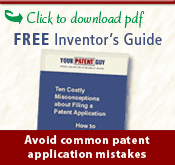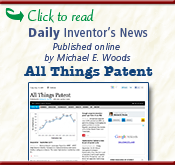I am frequently asked a version of the following question: “If there’s a new item that’s totally different from what’s available, which option is better when considering to license this new idea: A. File a Provisional, B. Wing it with an NDA or C. Other ?”
Most people seem to believe that filing a provisional is the answer – I believe that the answer is actually “C – other.” If you must, a quick, “top-level” real provisional prepared and filed by a registered patent attorney or agent, could be a reasonable choice particularly if you have not used and maintained an Inventor’s Notebook to show your earlier date of invention.
I have had several inventors with great ideas not get very far in licensing because they do not have a patent-in-hand. The best path to success is to have an issued patent. Working backwards, there needs to have been a regular non-provisional filed at some point. (Given that the average pendency for US applications is several years, this is not a fast process. Given that the allowance rate has been less than 50%, issuance is not guaranteed.)
The US currently operates with a first inventor to invent system (so acquire, use, and maintain your Inventor Notebook) and rely on the notebook. Contact retailers, manufacturers, and distributors and see if there is any market for your idea, using an NDA if you can. The US patent system provides for a 1-year grace period after certain events to get a valid application on file. An NDA can lengthen the time before that 1-year clock begins. Some type of patent application must be filed before the expiration of that clock to protect the invention.
Going this route can jeopardize international protection as it increases the risk that the invention will become “publicly known” before an application is filed. Most non-US jurisdictions have no grace period. Given that the costs of international protection are significant, that the US market is often the largest, and that international protection is often narrower, I do not generally recommend the international route for my first-time inventors. It is often better to use the funds for developing their product, acquiring additional US protection (more applications, copyright/trademark if appropriate), developing a second idea, or taking a much-needed vacation than to invest in international protection.
Patents cost money – that expense is justified the more likely it is that there is a market need and your idea can meet this need at the right price point. It is at this juncture that you have a chance of recouping your investment in your patent application. When an issued patent covers a product in the marketplace that is making money, that patent then helps you make more money (sometimes much more) than you could without the patent.
The provisional application is not a “lite” application – by law it needs to have most attributes of a non-provisional application – and expires in one-year. Many inventors wait an entire year to convert their application which adds the extra time to get into the examination queue which delays issuance. Weaknesses in the provisional can undermine any patent strategy you have in place that depends upon the provisional application. There is a right time and there are right reasons for filing a provisional application.
In short, try to obtain as much information as soon as you can as to whether there would be market acceptance of a product embodying your idea. For those ideas that look like they have a reasonable chance of making you money, get a patent application on file as soon as possible. There can be ways to expedite the application when needed and ways to implement a strategy that increases your chances of deriving value from your potentially marketable idea – consult a registered patent attorney or agent for help. There are some caveats and assumptions in this and this will not be appropriate in all cases.









Notice: Undefined property: thesis_comments::$comments in /home/k13x1mpx8le9/public_html/ypg/wp-content/themes/thesis_185/lib/classes/comments.php on line 41
{ 0 comments… add one now }